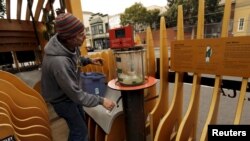A team of researchers from Australia and China has developed a way to desalinate and purify salty or brackish water into potable drinking water using solar energy, a process that could provide hope for developing areas without reliable or abundant electricity.
The World Health Organization says about 2 billion people worldwide do not have access to water that is safe to drink. Contaminated water can lead to cholera, dysentery, typhoid and a host of other diseases. And the WHO says that situation will only worsen in the next five years.
In a study published Monday in the science journal Nature Sustainability, the scientists said they had created a sustainable solution that relies on sunlight to jump-start the filtration process instead of heat or electricity.
Along with sunlight, the other key factor in their process is a special, incredibly porous metal compound composed of metal ions configured into a crystalline pattern.
The researchers enhanced the viability of this material by adding another material to its pores, called PSP-MIL-53.
After testing this material on both natural saltwater and synthetic saltwater, they found that the compound was able to absorb enough water in 30 minutes to create nearly 151 liters of fresh drinking water per single kilogram of the absorption material. They also discovered that this drinking water was even cleaner than WHO's official guidelines.
The researchers say the material could have other applications as well, for example, in mineral mining. The next step, they say, is getting their process out of the lab and into the field.








